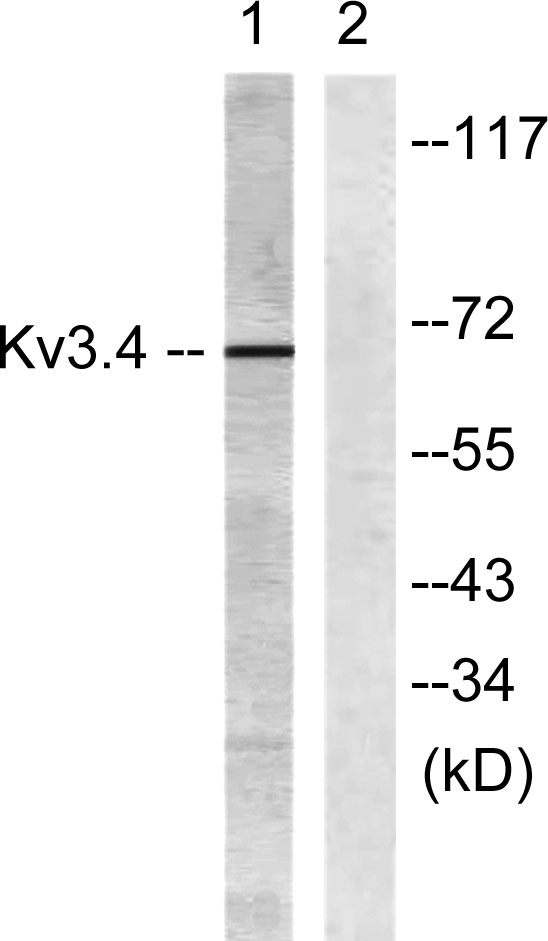Kv3.4 Polyclonal Antibody
- Catalog No.:YT2512
- Applications:WB;IHC;IF;ELISA
- Reactivity:Human;Mouse;Monkey
- Target:
- Kv3.4
- Gene Name:
- KCNC4
- Protein Name:
- Potassium voltage-gated channel subfamily C member 4
- Human Gene Id:
- 3749
- Human Swiss Prot No:
- Q03721
- Mouse Gene Id:
- 99738
- Mouse Swiss Prot No:
- Q8R1C0
- Immunogen:
- The antiserum was produced against synthesized peptide derived from human KCNC4. AA range:1-50
- Specificity:
- Kv3.4 Polyclonal Antibody detects endogenous levels of Kv3.4 protein.
- Formulation:
- Liquid in PBS containing 50% glycerol, 0.5% BSA and 0.02% sodium azide.
- Source:
- Polyclonal, Rabbit,IgG
- Dilution:
- WB 1:500 - 1:2000. IHC 1:100 - 1:300. IF 1:200 - 1:1000. ELISA: 1:20000. Not yet tested in other applications.
- Purification:
- The antibody was affinity-purified from rabbit antiserum by affinity-chromatography using epitope-specific immunogen.
- Concentration:
- 1 mg/ml
- Storage Stability:
- -15°C to -25°C/1 year(Do not lower than -25°C)
- Other Name:
- KCNC4;Potassium voltage-gated channel subfamily C member 4;KSHIIIC;Voltage-gated potassium channel subunit Kv3.4
- Observed Band(KD):
- 70kD
- Background:
- The Shaker gene family of Drosophila encodes components of voltage-gated potassium channels and is comprised of four subfamilies. Based on sequence similarity, this gene is similar to the Shaw subfamily. The protein encoded by this gene belongs to the delayed rectifier class of channel proteins and is an integral membrane protein that mediates the voltage-dependent potassium ion permeability of excitable membranes. It generates atypical voltage-dependent transient current that may be important for neuronal excitability. Multiple transcript variants have been found for this gene. [provided by RefSeq, Jul 2010],
- Function:
- domain:The segment S4 is probably the voltage-sensor and is characterized by a series of positively charged amino acids at every third position.,domain:The tail may be important in modulation of channel activity and/or targeting of the channel to specific subcellular compartments.,function:This protein mediates the voltage-dependent potassium ion permeability of excitable membranes. Assuming opened or closed conformations in response to the voltage difference across the membrane, the protein forms a potassium-selective channel through which potassium ions may pass in accordance with their electrochemical gradient.,PTM:Phosphorylation of serine residues in the inactivation gate inhibits rapid channel closure.,similarity:Belongs to the potassium channel family. C (Shaw) subfamily.,subunit:Homotetramer (Probable). Heterotetramer of potassium channel proteins.,
- Subcellular Location:
- Membrane; Multi-pass membrane protein.
- Expression:
- Brain,
- June 19-2018
- WESTERN IMMUNOBLOTTING PROTOCOL
- June 19-2018
- IMMUNOHISTOCHEMISTRY-PARAFFIN PROTOCOL
- June 19-2018
- IMMUNOFLUORESCENCE PROTOCOL
- September 08-2020
- FLOW-CYTOMEYRT-PROTOCOL
- May 20-2022
- Cell-Based ELISA│解您多样本WB检测之困扰
- July 13-2018
- CELL-BASED-ELISA-PROTOCOL-FOR-ACETYL-PROTEIN
- July 13-2018
- CELL-BASED-ELISA-PROTOCOL-FOR-PHOSPHO-PROTEIN
- July 13-2018
- Antibody-FAQs
- Products Images

- Western Blot analysis of various cells using Kv3.4 Polyclonal Antibody diluted at 1:500
.jpg)
- Western Blot analysis of SH-SY5Y cells using Kv3.4 Polyclonal Antibody diluted at 1:500

- Immunofluorescence analysis of HeLa cells, using Kv3.4/KCNC4 Antibody. The picture on the right is blocked with the synthesized peptide.

- Immunohistochemistry analysis of paraffin-embedded human brain, using Kv3.4/KCNC4 Antibody. The picture on the right is blocked with the synthesized peptide.

- Western blot analysis of lysates from COS7 cells treated with Anisomycin 25ug/ml 30', using Kv3.4/KCNC4 Antibody. The lane on the right is blocked with the synthesized peptide.



